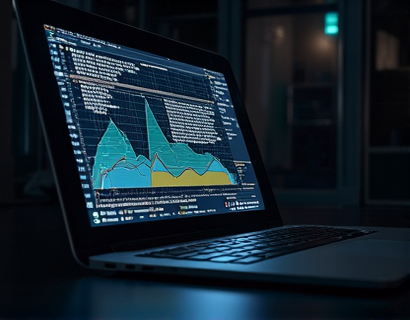Maximizing Digital Asset Value Through Smart Contracts: A Guide to Long-Term Locking and Sustainable Fintech Growth
In the rapidly evolving landscape of digital finance, the ability to maximize the value of digital assets while ensuring sustainable growth is a paramount concern for investors and enthusiasts alike. One innovative solution that stands out is the use of smart contracts to securely lock in digital assets like UCASH for long-term incentives, thereby fostering a vibrant and thriving community. This approach not only prioritizes transparency and reliability but also empowers users to optimize their returns and contribute to the overall health of the ecosystem.
The concept of locking digital assets for an extended period using smart contracts is rooted in the principles of decentralized finance (DeFi). Smart contracts, self-executing contracts with the terms directly written into code, offer a trustless and automated way to manage digital assets. By leveraging these contracts, users can lock their UCASH or similar digital assets for a predetermined period, ensuring that the assets are not sold or withdrawn during this time. This locking mechanism serves multiple purposes, including stabilizing the asset's value, incentivizing long-term holding, and promoting sustainable growth within the ecosystem.
Understanding Smart Contracts and Their Role in Digital Asset Management
Smart contracts are programs stored on a blockchain, which is a decentralized ledger that records transactions across multiple computers. The key features of smart contracts include automation, transparency, and immutability. Once deployed, a smart contract cannot be altered, ensuring that the terms agreed upon by the parties are strictly followed. This level of security and reliability makes smart contracts an ideal tool for managing digital assets.
In the context of digital asset management, smart contracts can be programmed to execute specific actions based on predefined conditions. For instance, a smart contract can be set to release locked UCASH to the owner after a certain period, or it can automatically distribute a portion of the asset's value to community projects or developers. This programmability allows for a high degree of customization, enabling the creation of complex financial instruments and incentive structures that traditional financial systems cannot match.
Benefits of Long-Term Locking with Smart Contracts
One of the primary benefits of using smart contracts to lock digital assets for the long term is the stabilization of asset value. By locking assets, users can avoid the volatility associated with short-term trading, which often leads to significant price fluctuations. This stabilization is particularly beneficial for investors seeking long-term growth, as it reduces the risk of capital erosion due to market volatility.
Another significant advantage is the promotion of sustainable growth within the ecosystem. When users lock their assets, they are essentially committing to a long-term investment in the platform or community. This commitment encourages the development of value-adding projects and initiatives, as the locked assets can be used to fund these endeavors. The influx of locked capital can lead to increased liquidity, higher engagement, and a more robust ecosystem, all of which contribute to sustainable growth.
Enhancing Transparency and Trust
Transparency is a cornerstone of the blockchain technology that underpins smart contracts. Every transaction and contract execution is recorded on the blockchain, making it visible to all participants. This level of transparency builds trust among users, as they can verify the terms and conditions of the smart contracts and track the progress of their locked assets. The immutability of the blockchain ensures that once a contract is executed, it cannot be tampered with, further enhancing trust in the system.
Moreover, the transparency provided by smart contracts reduces the need for intermediaries, such as banks or legal entities, to oversee transactions. This reduction in intermediaries not only lowers costs but also speeds up the process, making the entire experience more efficient and user-friendly.
Optimizing Returns Through Strategic Locking
To maximize the value of digital assets, strategic locking is essential. By locking assets for a specific period, users can take advantage of compounding returns. For example, if a user locks UCASH for a year and the asset appreciates in value, the user will benefit from the compounded growth over the entire locking period. This is particularly effective in environments where the asset is expected to increase in value over time.
Additionally, smart contracts can be designed to offer dynamic locking periods based on market conditions. For instance, if the price of UCASH is expected to rise, the smart contract can automatically extend the locking period to capture the potential gains. Conversely, if the price is expected to fall, the contract can trigger early release to minimize losses. This adaptability ensures that users can optimize their returns regardless of market fluctuations.
Incentivizing Community Growth
Smart contracts can also be used to incentivize community growth and participation. By locking assets, users can earn rewards or governance tokens that give them a say in the decision-making process of the ecosystem. These incentives align the interests of users with the long-term health and growth of the platform, fostering a collaborative and vibrant community.
For example, a smart contract can be programmed to distribute a portion of the locked assets' value to community projects or development initiatives. This not only benefits the community but also increases the overall value of the ecosystem, creating a positive feedback loop. Users see the direct impact of their locked assets on the community, which encourages more participation and investment.
Case Studies and Real-World Applications
Several projects have successfully implemented smart contracts for long-term asset locking, demonstrating the practical benefits of this approach. One notable example is a DeFi platform that locked user deposits for a minimum of six months, offering higher interest rates in return. This strategy not only stabilized the asset's value but also attracted long-term investors who were willing to lock their funds for the promised returns.
Another case study involves a decentralized governance platform that used smart contracts to lock community votes for a specific period. This ensured that once a vote was cast, it could not be changed, enhancing the integrity of the governance process. The locked votes also served as a form of collateral, incentivizing users to participate in governance activities and contribute to the platform's development.
Challenges and Considerations
While the benefits of using smart contracts for long-term asset locking are clear, there are several challenges and considerations to keep in mind. One major challenge is the technical complexity involved in setting up and deploying smart contracts. Users need to have a basic understanding of blockchain technology and smart contract programming to fully leverage these tools.
Another consideration is the potential for smart contract bugs or vulnerabilities. Although rare, security flaws in smart contracts can lead to significant losses. Therefore, it is crucial to conduct thorough audits and testing before deploying any smart contract. Using reputable development teams and adhering to best practices in smart contract development can mitigate these risks.
Future Trends and Innovations
The use of smart contracts in digital asset management is an evolving field, with ongoing innovations set to enhance their functionality and accessibility. One emerging trend is the integration of artificial intelligence (AI) with smart contracts, allowing for more sophisticated decision-making and automated strategies. AI can analyze market data and predict trends, enabling smart contracts to make more informed decisions about locking periods and release conditions.
Another area of innovation is the development of cross-chain smart contracts, which can operate across multiple blockchain networks. This interoperability opens up new possibilities for users to lock and manage assets across different platforms, increasing flexibility and access to a broader range of financial instruments.
Conclusion
In conclusion, the use of smart contracts for long-term locking of digital assets represents a powerful tool for maximizing value and fostering sustainable growth in the fintech sector. By leveraging the transparency, reliability, and programmability of smart contracts, users can optimize their investments, contribute to community growth, and participate in a thriving ecosystem. As the technology continues to evolve, the potential for innovation and improvement is vast, promising a brighter and more secure future for digital asset management.









































